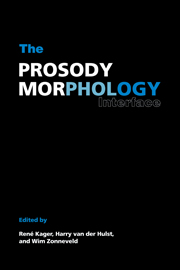Book contents
- Frontmatter
- Contents
- Contributors
- Preface
- 1 Introduction
- 2 On the moraic representation of underlying geminates: evidence from Prosodic Morphology
- 3 Verbal reduplication in three Bantu languages
- 4 Prosodic Morphology and tone: the case of Chichewa
- 5 Exceptional stress-attracting suffixes in Turkish: representations versus the grammar
- 6 Realignment
- 7 Faithfulness and identity in Prosodic Morphology
- 8 Austronesian nasal substitution and other NC effects
- 9 The prosodic base of the Hausa plural
- 10 Prosodic optimality and prefixation in Polish
- 11 Double reduplications in parallel
- Index of subjects
- Index of constraints
- Index of languages
- Index of names
7 - Faithfulness and identity in Prosodic Morphology
Published online by Cambridge University Press: 27 January 2010
- Frontmatter
- Contents
- Contributors
- Preface
- 1 Introduction
- 2 On the moraic representation of underlying geminates: evidence from Prosodic Morphology
- 3 Verbal reduplication in three Bantu languages
- 4 Prosodic Morphology and tone: the case of Chichewa
- 5 Exceptional stress-attracting suffixes in Turkish: representations versus the grammar
- 6 Realignment
- 7 Faithfulness and identity in Prosodic Morphology
- 8 Austronesian nasal substitution and other NC effects
- 9 The prosodic base of the Hausa plural
- 10 Prosodic optimality and prefixation in Polish
- 11 Double reduplications in parallel
- Index of subjects
- Index of constraints
- Index of languages
- Index of names
Summary
Introduction
The theory of Prosodic Morphology (PM) addresses a range of empirical problems lying at the phonology-morphology interface: reduplication, infixation, root-and-pattern morphology, and canonical shape requirements (such as word minimality). Its goal is to explain the properties of these phenomena in terms of general, independently motivated principles of morphology, of phonology, and of their interface. If the enterprise is fully successful, then these principles alone will suffice, and there will be no PM-specific principles or apparatus lurking anywhere in linguistic theory. Put in this way, the goal of PM is the same as the rest of linguistic theory: to achieve greater empirical coverage and deeper explanation with fewer resources – in the happiest case, with no resources at all that are specific to the domain under investigation.
This program was initiated by identifying templates with prosodic categories, eliminating the freedom to stipulate the form of templates independent of the theory of prosodic forms. This is the Prosodic Morphology Hypothesis of McCarthy and Prince (1986). The successor to the Prosodic Morphology Hypothesis is Generalized Template Theory (McCarthy and Prince 1994a, b), which carries the explanatory goals of PM up to the next level: the elimination of templates per se in favor of widely applicable constraints on prosody, morphology, and their interface. In this view, typical templatic categories like the “Minimal Word” are given no independent status, but rather emerge in reduplicative contexts through appropriate ranking of constraints on foot parsing and grammar → prosody mapping (see section 4.3 below for discussion and illustration).
Another line of development in PM has been the study of infixation and related phenomena.
- Type
- Chapter
- Information
- The Prosody-Morphology Interface , pp. 218 - 309Publisher: Cambridge University PressPrint publication year: 1999
- 110
- Cited by

